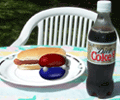
Click here for a copy of the mechanism sheet used in lecture today.
Rules of the Day 4-07-08
1. Think of electron density as waves, in which you can get extra stability when waves add constructively, and you lose stability when waves cancel each other (add destructively).
2. You generate as many new molecular orbitals as atomic orbitals used to create them. Half are bonding molecular orbitals (waves add constructively) and are filled with electron density, and half are antibonding molecular orbitals (waves add destructively) and are not filled with electron density.
3. Adjacent 2p orbitals overlap, allowing the pi electron density to delocalize into all the adjacent 2p orbtials, their wave functions adding constructively to provide for extra stability. (See Golden Rule #7).
4.Conjugated dienes equilibrate between the s-cis and s-trans geometry, referring to the conformation of the single bond between the double bonds. The s-trans geometry predominates.
5. H-X and X2 add to conjugated dienes to give both 1,2 and 1,4 addition products, via a resonance stabilized allylic cation intermediate.
6. The 1,2 addition is usually the kinetic product, that is, it forms faster (better opportunity since the reaction is occuring at a more stabilized secondary carbocation), but the 1,4 addition product is the thermodynamic product because it is more stable (greater motive since the double bond is more substituted). At low temperature, in which the molecules cannot equilibrate, the kinetic product predominates (called kinetic control). At higher temperature, in which the products do equilibrate with each other, the thermodynamic product predominates (called thermodynamic control).
7. Absorbance of a photon by a molecule corresponds to promotion of an electron from a filled molecular orbital to an unfilled molecular orbital. In the visible region, this usually involves pi bonding and antibonding molecular orbitals, and conjugation increases wavelength of absorption. Molecules appear to our eye to be a combination of the wavelengths reflected (not absorbed).
8. The energy absobed by molecules when they absorb a photon is usually converted to vibrational energy (they heat up). Fluorescence occurs when there are not vibrations possible (a rigid molecule) so the photon is emited as the electron goes back to ground state. Phosphorescence (glow in the dark) happens when the excited electron has flipped spins, and must reflip back before entering the original filled orbital while emitting a photon. Chemiluminescence (firefly light, "light sticks") happens when a chemical reaction produces an excited electron in a rigid molecule.
Homework: Finish homework Set 8. Click here to download a copy. Read: 21.1-21.3 Problems: 21.1-21.5
